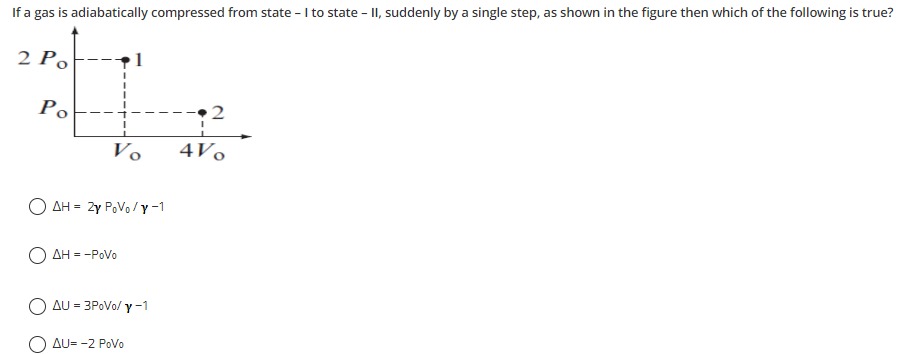Question
Question: If a gas is adiabatically compressed from state - I to state - II, suddenly by a single step, as sho...
If a gas is adiabatically compressed from state - I to state - II, suddenly by a single step, as shown in the figure then which of the following is true?

ΔH = 2γ P0V0/γ-1
ΔH = -P0V0
ΔU = 3P0V0/γ-1
ΔU= -2 P0V0
ΔH = -P0V0
Solution
The problem describes an adiabatic compression from state I to state II, suddenly by a single step. From the figure, state 1 has coordinates (V0,2P0) and state 2 has coordinates (4V0,P0). Since the process is a compression, the initial state must have a larger volume than the final state, and the final state must have a higher pressure than the initial state. Looking at the figure, state 2 has a larger volume (4V0) and lower pressure (P0) compared to state 1 (V0, 2P0). Therefore, for a compression, the initial state must be state 2 and the final state must be state 1. So, state I is state 2 and state II is state 1.
Initial state (state I): Vi=V2=4V0, Pi=P2=P0. Final state (state II): Vf=V1=V0, Pf=P1=2P0.
The process is a sudden single-step adiabatic compression. For a sudden single-step process, the work done by the gas is given by W=Pext(Vf−Vi), where Pext is the constant external pressure against which the process occurs. In a sudden compression, the external pressure is equal to the final pressure of the gas. So, Pext=Pf=P1=2P0. The work done by the gas is W=2P0(V1−V2)=2P0(V0−4V0)=2P0(−3V0)=−6P0V0. Since the process is adiabatic, Q=0. According to the first law of thermodynamics, the change in internal energy is ΔU=Q−W=0−(−6P0V0)=6P0V0.
Now let's calculate the change in enthalpy, ΔH. For an ideal gas, ΔH=ΔU+Δ(PV). Δ(PV)=PfVf−PiVi=P1V1−P2V2=(2P0)(V0)−(P0)(4V0)=2P0V0−4P0V0=−2P0V0. ΔH=ΔU+Δ(PV)=6P0V0+(−2P0V0)=4P0V0.
Our calculated values are ΔU=6P0V0 and ΔH=4P0V0. None of the options match these values.
Let's re-examine the options and the problem. It is possible that the options are derived under some specific assumptions or there is a typo in the question or options.
Let's consider the possibility that the process is from state 1 to state 2 as shown in the figure, even though the text says "compressed". If the process is from state 1 to state 2, it is an expansion. Initial state: 1 (V1=V0,P1=2P0). Final state: 2 (V2=4V0,P2=P0). Sudden single-step adiabatic expansion. The external pressure is constant and equal to the final pressure of the gas. Pext=Pf=P2=P0. Work done by the gas W=Pext(Vf−Vi)=P0(V2−V1)=P0(4V0−V0)=P0(3V0)=3P0V0. Since adiabatic, Q=0. ΔU=Q−W=0−3P0V0=−3P0V0. Change in enthalpy ΔH=ΔU+Δ(PV). Δ(PV)=PfVf−PiVi=P2V2−P1V1=(P0)(4V0)−(2P0)(V0)=4P0V0−2P0V0=2P0V0. ΔH=ΔU+Δ(PV)=−3P0V0+2P0V0=−P0V0.
Let's check the options again with ΔU=−3P0V0 and ΔH=−P0V0. Option 1: ΔH=2γP0V0/(γ−1). Option 2: ΔH=−P0V0. This matches our calculated value of ΔH for an expansion from state 1 to state 2. Option 3: ΔU=3P0V0/(γ−1). Option 4: ΔU=−2P0V0.
Since option 2 matches our calculation for an adiabatic expansion from state 1 to state 2, it is highly probable that the question meant adiabatic expansion from state I (which is state 1) to state II (which is state 2), despite saying "compressed".
Let's assume the question meant adiabatic expansion from state 1 to state 2. Initial state: 1 (V1=V0,P1=2P0). Final state: 2 (V2=4V0,P2=P0). Sudden single-step adiabatic expansion. External pressure is constant and equal to the final pressure, Pext=P2=P0. Work done by the gas W=Pext(V2−V1)=P0(4V0−V0)=3P0V0. ΔU=Q−W=0−3P0V0=−3P0V0. ΔH=ΔU+Δ(PV)=−3P0V0+(P2V2−P1V1)=−3P0V0+(P0(4V0)−2P0V0)=−3P0V0+4P0V0−2P0V0=−P0V0.
So, if the process is an adiabatic expansion from state 1 to state 2, then ΔH=−P0V0. This matches option 2.
Let's verify if any other option can be correct under some interpretation. Consider option 3: ΔU=3P0V0/(γ−1). If this were true, then ΔU is positive, which means internal energy increases. This happens during adiabatic compression. So, if the process is adiabatic compression, ΔU should be positive. If the process is adiabatic compression from state 2 to state 1, we calculated ΔU=6P0V0. If the process were reversible adiabatic compression from state 2 to state 1, then P2V2γ=P1V1γ. P0(4V0)γ=2P0V0γ, so 4γ=2, which is not possible for γ>1. So, it's not a reversible adiabatic process.
Let's assume the question is correct in stating "adiabatically compressed from state - I to state - II" and the figure shows state I as 2 and state II as 1. Initial state: 2 (4V0,P0). Final state: 1 (V0,2P0). Sudden single-step adiabatic compression. External pressure Pext=P1=2P0. W=−6P0V0. ΔU=6P0V0. ΔH=4P0V0. None of the options match.
Given that option 2 matches the calculation for adiabatic expansion from state 1 to state 2, it is most likely that the question has a typo and it should be "adiabatically expanded from state - I to state - II". Assuming this interpretation, state I is state 1 and state II is state 2.
The final answer is ΔH=−P0V0.
